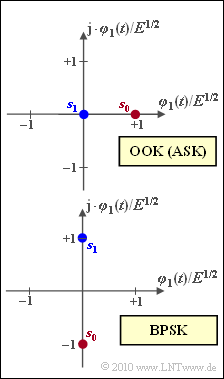Exercise 4.11: On-Off Keying and Binary Phase Shift Keying
From LNTwww
The graphic shows signal space constellations for carrier-modulated modulation methods:
- "On–Off Keying" (OOK), also known as "Amplitude Shift Keying" (ASK) in some books,
- "Binary Phase Shift Keying" (BPSK).
For the error probability calculation we start from the AWGN channel. In this case the error probability is
(related to symbols or to bits alike):
- pS=pB=Q(d/2σn).
Here
- d denotes the distance between the signal space points, and
- σ2n=N0/2 the variance of the AWGN noise.
In the questions from (3) onwards, reference is also made to the mean symbol energy ES.
Notes:
- The exercise belongs to the chapter "Carrier Frequency Systems with Coherent Demodulation".
- Reference is also made to the chapter "Linear Digital Modulation – Coherent Demodulation" and the chapter "Linear Digital Modulation" in the book "Modulation Methods".
- For the complementary Gaussian error function, use the following approximation:
- Q(x)≈1√2π⋅x⋅e−x2/2.
Questions
Solution
(1) Both "'On–Off Keying" \rm (OOK) and "Binary Phase Shift Keying" \rm (BPSK) are binary modulation methods:
- \underline{b = 1 }\hspace{0.05cm},\hspace{0.5cm} \underline{M = 2} \hspace{0.05cm}.
(2) Solution 2 is correct, recognizable by the imaginary basis function \varphi_2(t) = {\rm j} \cdot \varphi_1(t).
- If described in the band-pass range, the basis functions would be real: "cosine" and "(minus) sine".
(3) The given equation is for "On–Off Keying" with
- d = \sqrt {E},
- E_{\rm S} = E/2 (assuming equally probable symbols \boldsymbol{s}_0 and \boldsymbol{s}_1),
- \sigma_n^2 = N_0/2:
- p_{\rm S} \hspace{-0.1cm} = \hspace{-0.1cm} {\rm Q} \left ( \frac{ d/2}{ \sigma_n}\right )= {\rm Q} \left ( \frac{ \sqrt{E}/2}{ \sqrt{N_0/2}}\right ) = {\rm Q} \left ( \sqrt{ \frac{ E/2}{ N_0} }\right ) = {\rm Q} \left ( \sqrt{ { E_{\rm S}}/{ N_0} }\right ) \hspace{0.05cm}.
- For E_{\rm S}/N_0 = 9 = 3^2 this results in:
- p_{\rm S} = {\rm Q} (3) \approx \frac{1}{\sqrt{2\pi} \cdot 3} \cdot {\rm e}^{-9/2} = \underline{14.8 \cdot 10^{-4}} \hspace{0.05cm}.
- Accordingly, for 10 \cdot {\rm lg} \, (E_{\rm S}/N_0) = 12 \ \rm dB ⇒ E_{\rm S}/N_0 = 15.85:
- p_{\rm S} = {\rm Q} (\sqrt{15.85}) \approx \frac{1}{\sqrt{2\pi\cdot 15.85} } \cdot {\rm e}^{-15.85/2} = \underline{0.362 \cdot 10^{-4}} \hspace{0.05cm}.
(4) In contrast to subtask (3), "Binary Phase Shift Keying" \rm (BPSK) applies
- d = 2 \cdot \sqrt {E},
- E_{\rm S} = E,
both even independent of the occurrence probabilities for \boldsymbol{s}_0 and \boldsymbol{s}_1.
- It follows:
- p_{\rm S} = {\rm Q} \left ( \frac{ \sqrt{E_{\rm S}}}{ \sqrt{N_0/2}}\right ) = {\rm Q} \left ( \sqrt{ { 2E_{\rm S}}/{ N_0} }\right ) \hspace{0.05cm}.
- With E_{\rm S}/N_0 = 9, this results in the numerical value:
- p_{\rm S} = {\rm Q} (\sqrt{18}) \approx \frac{1}{\sqrt{2\pi\cdot 18} } \cdot {\rm e}^{-18/2} = \underline{117 \cdot 10^{-8}} \hspace{0.05cm}.
- And with 10 \cdot {\rm lg} \, E_{\rm S}/N_0 = 12 \ \rm dB ⇒ 2E_{\rm S}/N_0 = 31.7:
- p_{\rm S} = {\rm Q} (\sqrt{31.7}) \approx \frac{1}{\sqrt{2\pi\cdot 31.7} } \cdot {\rm e}^{-31.7/2} = \underline{0.926 \cdot 10^{-8}}\hspace{0.05cm}.
